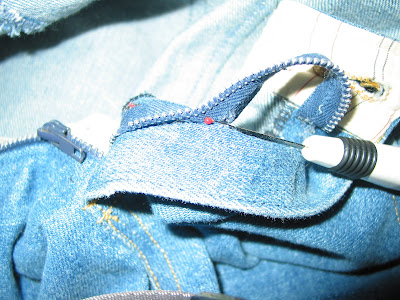A year and a half ago I made my first pair of Jeans (
blogged here). A practice pair, really, using Jalie's ubiquitous Jeans pattern, JoAnn's sale denim (cheap) and a (really really) cheap zipper. In spite of the (really really) cheap ingredients, I did strive to do a good job on the construction. The good news: they have been my very favorite, go-to jeans ever since! They fit, they feel good, they're comfy, and even the topstitching is pretty darned OK.
The bad news: Did I mention the (really really) cheap zipper? Yup, the inevitable happened, and it busted on me. Several months ago. I'm now ready to make another pair of jeans, using Style Arc's Jilly Jeans pattern - (sadly, not named after me, but clearly I
have to make them anyway, right?).
So I figured it was time to repair that broken zipper too. I've been dreading this task. Unpicking All. That. Topstitching. Trying to squeeze in the new zip to fit. This is the stuff a stitcher's nightmares are made of, right? Well.... I looked up a few tutorials online, and waddaya know - there are actually EASY ways of doing this! No topstitching need be harmed! There is hand sewing involved, but I don't mind that, and since these jeans really have seen their better days, the zip doesn't need to be guaranteed-for-a-lifetime sturdy anyway. (Aside: there are some truly atrocious tutorials out there, but a couple of pretty good ones, including
this one from Threads)
So, off we go! Zipper replacement experience documented here! Step right up and follow along with me, as I venture off into new territory! (warning: picture heavy posting follows - hopefully this will qualify as Jeans Zipper Replacement 101, or Zip Replacement for Dummies) (Note: All pics can be biggified for more detail simply by clicking on them)
New Zip, Old Zip, Old Jeans which want to be New Jeans:
(Note: if you can't find a zipper that's the same size as the old one,
clip off the BOTTOM of the zip, not the top, and hand stitch
a really solid new bar of stitching to prevent the zip from sliding off the bottom)
Step 1.
Remove Old Zipper
Remove the stitching holding the zipper to the fly guard
(the underneath part of the zipper):
This is where I realized that my first installation was way. WAY. sturdier than the zipper itself was. I did not have just ONE line of stitching holding this half of the zipper in place, but THREE! Yes....THREE! I looked back at my detailed
zipper installation post, where I thoroughly detailed my process - I used a combination of Debbie Cook's and Peter MPB's tutorials with a few touches of my own, and danged if I didn't end up with a well-installed zipper! Too bad about the (really really) cheap zipper I used :(.
One row of stitching to unpick at the far edge of the zip,
one row in the center,
and the topstitched row. Sheesh.
Unpick the (single) row of stitching holding
the other half of the zipper to the outer fly:
Without removing any topstitching,
cut the zipper off at the tops and bottoms,
as close as you can get to the waistband
and the bottom of the zipper:
I promise, the zip was already dead;
it felt no pain.
Really.
Step 2. Install New Zipper
With zipper facing up, place zipper on the fly guard.
Fold the top end of the zipper tape under. (Note: tuck it further under
than this picture shows before sewing, in order to keep it
well out of the way of the zipper teeth)
Place the top of the zipper as close to the waistband as possible.
Baste or pin in place, or use Wonder Tape
(or do like I did, and use nothing - this side is really pretty easy to stitch in place,
using the zipper teeth as a guide)
Using a zipper foot, stitch this side of the zipper in place,
stitching close to the teeth:
Close the zipper.
Fold the top of the zipper tape OVER
(on both sides of the zipper, you want the folded part of the tape
to be next to fabric you are stitching it to)
Here I did use Wonder Tape to get the zipper placed correctly before stitching:
Button the jeans in closed position,
and finger press the zipper & Wonder Tape to the fly front:
Unzip the zipper, making sure that the Wonder Tape
is holding it in place,
and hand stitch this half of the zipper in place:
There are two layers of denim on the fly front.
You will only be stitching the zipper to the inner layer;
make sure you're only catching the one layer as you stitch.
I used a backstitch, as shown here (biggify the pic for better detail):
Pliers are your friend, at times like these:
And that's it, folks!
Brand New (sort of) Jeans!
What on earth was I so afraid of??? This whole process (if you eliminate the time spent taking photos, doing a bit of blogging, making and eating dinner, a couple of phone calls, etc...) took maybe an hour and a half, including time spent questioning just how I wanted to do it along the way. Now that I know how easy it is, should I need to do it again I'm betting it will take half that time.
And you? Have you done this before? Did your hand stitching hold up? Will you do it now? Any tips to share?
Raise a glass with me to the magic of repairing the old! :)
Oh, and next up? A truly brand new pair of jeans :)






























































